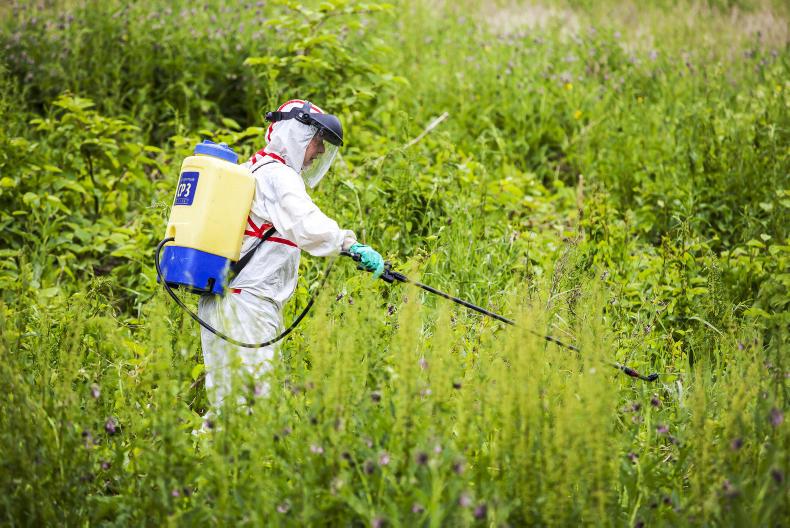Researchers from the school of physics in NUI Galway studying exposure to glyphosate in a group of professional amenity horticultural workers for four years have found low exposure to the herbicide ingredient.
"The highest measured glyphosate concentrations were equivalent to less than 1% of the acceptable operator exposure level set by the European Food Safety Authority" (EFSA), they concluded from results published in the International Journal of Hygiene and Environmental Health.
Exposure was measured from the workers' urine samples and from their faces, hands, gloves, mobile phones and steering wheels.
Hands most exposed
Analysis from a total of 550 samples showed that skin contamination on the worker’s hands is the most significant form of exposure, accounting for 40% of cases.
"This four-year study highlights the importance of using personal protective equipment (PPE) when using pesticide products.
"If reusable PPE is used, it should be thoroughly cleaned after use as levels of pesticide contamination were found on reusable worker gloves which, if reused by the worker, may become a source of exposure," the researchers advised.
They added that pesticide users should be particularly careful when taking breaks and around personal objects such as mobile phones and steering wheels.
Some workers were likely to have contaminated their face by adjusting their mask or taking phone calls while working, they suggested.
Cancer claim
The study comes shortly after an American groundskeeper successfully sued the manufacturer of the glyphosate-based Roundup herbicide for causing him to develop cancer.
The International Agency for Research on Cancer has classified the chemical as "probably carcinogenic to humans", but EFSA and other health and safety authority around the world have concluded that it unlikely to cause cancer.
Dr Holger Koch, chief editor of the International Journal of Hygiene and Environmental Health, described the study as “an important, timely scientific contribution to the current worldwide glyphosate discussion, and the first international study of its kind to look at glyphosate exposures, and exposure pathways, among a previously understudied occupational group, amenity horticulture and gardeners".
Read more
Bayer vows to fight 8,000 glyphosate lawsuits
Pre-emptive glyphosate resistance management
Researchers from the school of physics in NUI Galway studying exposure to glyphosate in a group of professional amenity horticultural workers for four years have found low exposure to the herbicide ingredient.
"The highest measured glyphosate concentrations were equivalent to less than 1% of the acceptable operator exposure level set by the European Food Safety Authority" (EFSA), they concluded from results published in the International Journal of Hygiene and Environmental Health.
Exposure was measured from the workers' urine samples and from their faces, hands, gloves, mobile phones and steering wheels.
Hands most exposed
Analysis from a total of 550 samples showed that skin contamination on the worker’s hands is the most significant form of exposure, accounting for 40% of cases.
"This four-year study highlights the importance of using personal protective equipment (PPE) when using pesticide products.
"If reusable PPE is used, it should be thoroughly cleaned after use as levels of pesticide contamination were found on reusable worker gloves which, if reused by the worker, may become a source of exposure," the researchers advised.
They added that pesticide users should be particularly careful when taking breaks and around personal objects such as mobile phones and steering wheels.
Some workers were likely to have contaminated their face by adjusting their mask or taking phone calls while working, they suggested.
Cancer claim
The study comes shortly after an American groundskeeper successfully sued the manufacturer of the glyphosate-based Roundup herbicide for causing him to develop cancer.
The International Agency for Research on Cancer has classified the chemical as "probably carcinogenic to humans", but EFSA and other health and safety authority around the world have concluded that it unlikely to cause cancer.
Dr Holger Koch, chief editor of the International Journal of Hygiene and Environmental Health, described the study as “an important, timely scientific contribution to the current worldwide glyphosate discussion, and the first international study of its kind to look at glyphosate exposures, and exposure pathways, among a previously understudied occupational group, amenity horticulture and gardeners".
Read more
Bayer vows to fight 8,000 glyphosate lawsuits
Pre-emptive glyphosate resistance management






 This is a subscriber-only article
This is a subscriber-only article









SHARING OPTIONS: